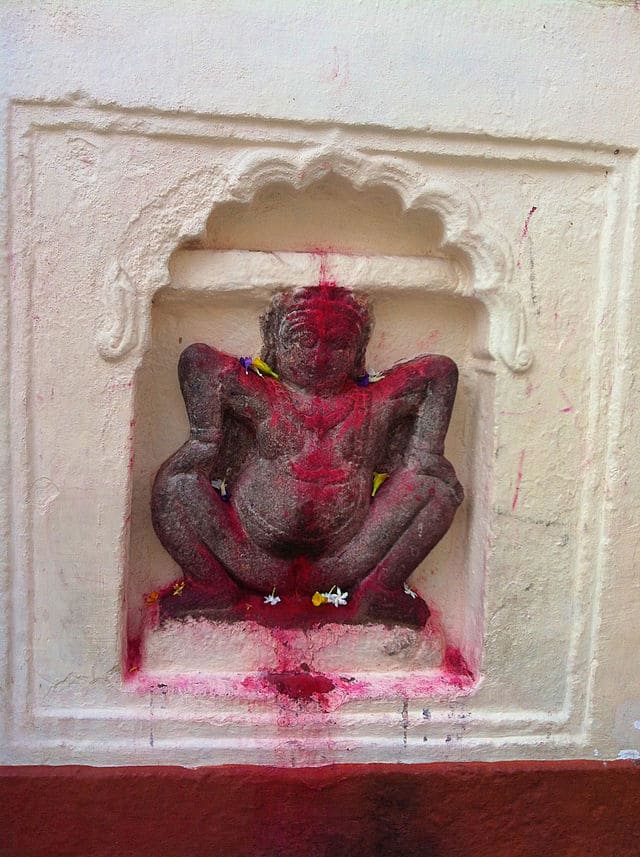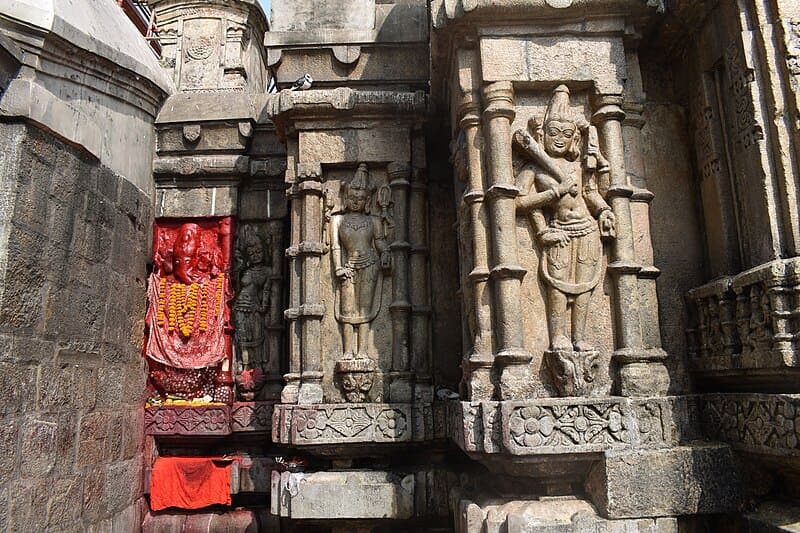Kamakhya Temple – Menstruation, a natural bodily process experienced by women, has been marred by taboos and societal restrictions across cultures and geographies. While some cultures celebrate this cycle of life, many others connect it to biases, impurity, and shame.
Such taboos prevent women from feeling empowered and from being happy, contributing to their societal exclusion. However, the Kamakhya Temple stands apart by embracing menstruation as a sacred and divine occurrence.
The Kamakhya Temple, located in Guwahati (Assam) on the lovely Nilachal Hill, is a homage to India’s rich cultural legacy. In addition to its magnificent architecture, this ancient temple is particularly beloved by its followers for its unique menstrual rites. The fascinating history of the menstruation rites at the Kamakhya Temple is explored in this article, along with their importance, effects, and the message they send to the outside world.
The Kamakhya Temple: A Sacred Abode

The Legend and Significance of this Shakthi Peetha
According to Hindu mythology, the legend of Kamakhya Temple as a Shakti Peetha revolves around the story of Goddess Sati, the consort of Lord Shiva. The tale recounts the grand Daksha Yagna, a celestial fire sacrifice organized by Daksha, the father of Sati. Sati insisted on going to the event despite not being invited because of her deep devotion to Lord Shiva.
Upon arriving at the yagna, Sati faced humiliation and disrespect from Daksha, who disapproved of her marriage to Shiva. Overwhelmed with grief and anger, Sati invoked her yogic powers and immolated herself in the sacrificial fire.
Learning of his beloved wife’s tragic demise, Lord Shiva was consumed by sorrow and rage. He started his ferocious tandava, threatening to destroy the universe while carrying Sati’s remains.
To prevent complete chaos, Lord Vishnu intervened and used his Sudarshana Chakra (divine discus) to dismember Sati’s body. Her body parts fell in various locations across the Indian subcontinent, which became sacred spots known as Shakti Peethas, each associated with a specific body part.
Kamakhya Temple is revered as the place where the womb and vagina of Goddess Sati fell. It is considered the most important among the 51 Shakti Peethas. The temple is believed to be the abode of Goddess Kamakhya, an incarnation of Shakti or the Divine Feminine. The temple is also known as the Yoni Peetha, representing the divine feminine creative energy.
The legend of Kamakhya Temple as a Shakti Peetha emphasizes the power of female energy and highlights the eternal bond between Lord Shiva and Goddess Shakti. Devotees flock to this revered temple to seek blessings, perform rituals, and witness the divine energy of Kamakhya, acknowledging the supreme significance of the Goddess in Hindu mythology.
Menstruation Rituals: Beliefs & Practices at Kamakhya Temple

At the Kamakhya Temple, menstruation is not viewed as impure but rather as a powerful force of nature. The rituals associated with menstruation focus on honoring and acknowledging this natural phenomenon. The temple remains closed for three days during the annual Ambubachi Mela, which commemorates the fertility of the Earth. It is believed that Devi Kamakhya undergoes her menstrual cycle during this period, and the temple premises become a symbol of feminine energy and divine power.
Her worshipers believe that her menstrual cycle represents the regeneration and rejuvenation of the universe. It is through this lens that the menstruation rituals at the Kamakhya Temple gain their profound significance. Devotees from far and wide gather to pay homage to the goddess and seek her blessings during the Ambubachi Mela, transcending societal norms and celebrating womanhood.
Ambubachi Mela in Kamakhya Temple

It’s a significant festival that celebrates the power of menstruation and women’s power. It is held annually at Kamakhya Temple in Guwahati. It typically takes place during the monsoon season, specifically in the month of June. The festival spans four days, during which the temple remains closed for three days symbolizing the menstruation period of the goddess.
During the Ambubachi Mela, devotees gather at the temple to honor the goddess Kamakhya and participate in various rituals. The main ritual involves the symbolic bathing of the goddess’s stone image, known as the “Kamakhya Devi Jalabhishek.” The sacred image is first cleaned, followed by a ritual bath using holy water and various traditional offerings. This ritual represents the rejuvenation and renewal of the goddess’s fertility.
Another significant ritual is the “Nilachal Puja,” where devotees offer prayers and seek blessings from the goddess. Many pilgrims also engage in meditation, chanting of mantras, and recitation of hymns to connect with the divine energy present during the festival.
The Ambubachi Mela is also a time for devotees to engage in acts of self-purification and spiritual practices. Some devotees observe a strict fast during the festival, abstaining from food and water. It is believed that such practices enhance one’s spiritual connection and devotion to the goddess.
Ambubachi Mela – Exclusion of Men
One of the distinctive rituals of Kamakhya Temple is the prohibition of men from entering the inner sanctum during the Ambubachi Mela. This tradition is based on the belief that the goddess, during her menstrual state, requires solitude and privacy. The temple is draped with a Red fabric of women throughout these 3 days that personify the power and sanctity of the feminine divine.
The closure of the temple is symbolic of the menstruation period of the goddess Kamakhya. It is believed that the goddess undergoes a process of rejuvenation and renewal during this time, and the temple premises are considered sacred and restricted to women devotees only.
River Kamakhya Temple Blood
During this time, the waters of the nearby Brahmaputra River appear to turn red. Evoking both awe and wonder. But many controversies revolve around this. While the local beliefs attribute this event to the menstruation of the Goddess Kamakhya. From a scientific perspective, there is a natural explanation for this occurrence. It can be explained scientifically as a result of the presence of Trachelomonas algae and iron-rich sediments in the Brahmaputra River during the monsoon season.
While the event holds immense cultural and religious significance, understanding its natural cause enhances our appreciation for the fascinating interplay between nature and spirituality.
While men are not permitted to enter the inner sanctum of the temple during the Ambubachi Mela, they can still visit the temple surroundings and participate in various activities taking place outside the temple complex.
Addressing Stigma and Raising Awareness at Kamakhya Temple
Challenging Societal Norms
The Kamakhya Temple’s menstruation rituals play a pivotal role in challenging the deeply ingrained stigma associated with menstruation. By presenting a positive and empowering narrative, the temple contributes to changing societal norms, fostering a more accepting and respectful environment for women.
Promoting Menstrual Health and Hygiene
The temple authorities also recognize the importance of menstrual health and hygiene. Initiatives are taken to educate devotees and visitors about menstrual health, breaking the silence and providing access to necessary resources. By doing so, the Kamakhya Temple takes a step forward in ensuring the well-being of women and promoting a culture of understanding and support.
Initiatives and Campaigns
Beyond the temple premises, various initiatives and campaigns have been launched to spread awareness about the Kamakhya Temple’s menstruation rituals. These efforts aim to highlight the significance of accepting menstruation and challenge the taboos that hinder women’s progress. Through education, advocacy, and community engagement, the message of inclusivity and empowerment reaches far beyond the temple’s boundaries.
The Impact and Relevance of Kamakhya Temple’s Rituals

Changing Perceptions and Attitudes
The menstruation rituals at the Kamakhya Temple have the power to transform perceptions and attitudes toward menstruation. By presenting menstruation as a sacred natural process, the temple’s traditions challenge the age-old taboos and encourage society to view menstruation in a positive light.
Symbolism and Spiritual Awakening
The rituals associated with Devi Kamakhya’s menstrual cycle hold deep symbolic significance. They serve as a reminder of the cyclical nature of life, the power of creation, and that we must embrace both the light and the dark sides of life. The customs of the temple offer a setting for enlightenment and introspection.
Empowering Women Worldwide
The Kamakhya Temple’s menstruation rituals have a ripple effect beyond its physical boundaries. They encourage women all across the world to reclaim their bodies, celebrate their innate strength, and oppose societal standards that strive to oppress them. The temple becomes a representation of resilience, sturdiness, and collective empowerment.
The Sacred Pooja at Kamakhya Temple: A Devotional Offering
At Kamakhya Temple, the sacred rituals and pujas form an integral part of the spiritual experience. Devotees gather to present their prayers and seek blessings from the goddess, immersing themselves in the serene ambiance of devotion and reverence. People feel connected with the divine, thanks to the melodic chants of Mantras, aromas of dhoop and incense, and vibrant flowers. This creates a unique and holy ambiance that surpasses the ordinary.
Q: Is it true that men cannot enter this Temple during the Ambubachi Mela?
Yes, during the Ambubachi Mela, men cannot enter the inner sanctum of Kamakhya Temple. This restriction is based on the belief that the goddess, in her menstrual state, requires privacy and seclusion.
Q: Why are women considered more powerful in Kamakhya Temple?
Women are seen as powerful in Kamakhya Temple because the goddess’ menstrual cycle is celebrated as a symbol of divine energy and fertility. The temple acknowledges the sacred strength inherent in women, who are seen as embodiments of the goddess’ resilience and power.
Q: Can you share some insights into the history of Kamakhya Temple?
According to Hindu mythology, Kamakhya Temple is the sacred spot where the womb of the goddess Sati fell during Lord Shiva’s cosmic dance of destruction. It holds immense historical and religious significance as one of the revered Shakti Peethas, where they worship the divine feminine energy.